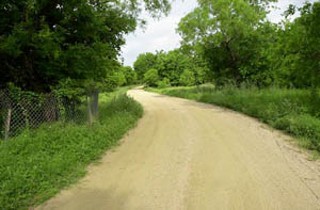Happy Trails to All at Austin Confab
National Trails Symposium comes to Convention Center
By Dan Oko, Fri., Oct. 22, 2004

It's likely that if Jim Barborak had his way, you could start at the Town Lake Hike and Bike Trail and keep on walking on shady footpaths all the way from Texas to Panama. Barborak is a specialist in Latin American protected areas for the Bronx-based Wildlife Conservation Society, working on a variety of projects, including a pathway stretching across Mexico. He will be bringing a little international flair to the National Trails Symposium, a biennial conference kicking off at the Austin Convention Center Thursday, Oct. 21.
Barborak's work carries him as far afield as the Amazon Basin and Patagonia, and he has a basic message that transcends boundaries: "Building trails is a great way to build support for conservation as well as ecotourism." No matter where they are, he said recently, trails can also provide an economic spark.
The presence of figures like Barborak is just one reason that his local counterpart in the Austin Parks & Recreation Department, trail planner Butch Smith, called the National Trail Symposium "kind of like the Olympics." Now in its 17th iteration, this is the first time the meeting has come to Texas, and it could be the last. "It's very competitive," said Smith, noting that there are few cities better equipped to host such a conference than Austin, with its 100 miles of urban trails and more on the docket. In addition to Barborak, a host of federal officials, national health experts, urban planners, and trail designers – not to mention trail advocates and users – will be on hand for the four-day meeting. The theme this year: "The emerging role of trails in American lifestyles."
Smith, who credited the Grapevine-based Texas Trails Network with cinching the symposium for Austin, said the local trail movement got kick-started in the early 1990s, when federal transportation funds became available for bike routes and footpaths. He noted some of the significant ongoing projects in Austin, including improvements to the ever-popular Barton Creek Greenbelt, the 71/2-mile strip of wilderness that calls to sundry users, ranging from families out for their Sunday stroll to mountain bikers engaged in all manner of fat-tire madness. Austin showed its commitment to keeping the cityscape green in 1998 with the passage of $4.8 million in bonds. "We're literally pumping millions of dollars into our trails," said Smith.
Still, he noted, challenges remain. Even though efforts are being made to shore up the Shoal Creek Trail and work is getting under way on a new three-plus-mile nonmotorized commuter route from Balcones District Park to Walnut Creek Metropolitan Park in North Austin, Smith said, park operations and maintenance could use more city funding. Likewise, user conflict remains a high priority within PARD, especially around the Town Lake Trail, which sees an estimated 1.5 million visits annually, and up Barton Creek, where newfangled improvements such as cedar-railed "dodge ways" aim to keep walkers out of cyclists' way and vice versa. "[Dispersing] the users is really the only long-term solution," said Smith, hopefully. "That and trail etiquette, of course."
More than likely Smith and his colleagues from across the country will find plenty of helpful hints amid the conference sessions. In addition to sessions open to the public (see www.americantrails.org for details), workshops will cover topics such as developing community support, successful public-private partnerships, the design of multiuse trails, and planning paddling-trail systems along coastal and inland waterways. On Friday, Barborak and his collaborator Larry Lechner from Colorado State University will present "Latin America's 'Senderos' and 'Trilhas': Expanding Trail Networks From Chihuahua to Chile," a study evaluating trail systems in South America and comparing them to similar efforts in the United States.
Pam Gluck, executive director of American Trails, the nonprofit group behind the conference, said that while there will be many discussions about urban planning, fundraising, land management, and other technical aspects of trail construction, the conference focus remains on looking at how trail use fits into American lives. Mayor Will Wynn is scheduled to talk about the Austin in Motion program at a keynote luncheon, and Melissa Johnson of the President's Council on Physical Fitness and Sports is coming to town. Trail advocacy, Gluck said, goes well beyond environmental protection. "Trails and greenways can make a big difference in the obesity epidemic," she noted. "But it's mental and spiritual health as well."
Joe Moore of the Texas Trails Network, co-chair of the conference, said that the splash-back effect of holding the conference in the state capital could pay political as well as social dividends. "We want the state to wake up and see what the trails mean to us, and the need for them all over Texas," he said. "There's a lot of quality-of-life added value from trails allowing connections between neighborhoods to access to outdoor areas." The Texas Parks & Wildlife Department, at least, has already taken note, signing on as symposium sponsor.
Got something to say on the subject? Send a letter to the editor.








